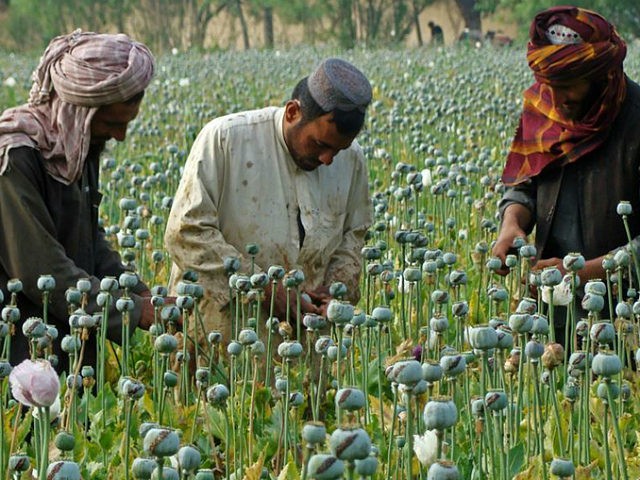The unprecedented air campaign against the Taliban’s opium and heroin trade, seen as the group’s primary economic engine and worth hundreds of millions of dollars to the narco-jihadis, has failed to meet to expectations according to a Wall Street Journal (WSJ) report on Wednesday.
“We’re not where we want to be with that, but we’re generally moving in the right direction,” said Gen. Joseph Votel, the chief of U.S. Central Command (CENTCOM) charged with war strategy in Afghanistan, according to WSJ.
Marking a historic departure from his predecessors, U.S. President Donald Trump authorized the military last November to launch airstrikes against the Taliban’s facilities for processing opium into heroin.
The Journal noted:
But the initiative hasn’t had the impact military officials had hoped. So far, the air campaign has wiped out about $46 million in Taliban revenue, less than a quarter of the money the U.S. estimates the insurgents get from the illegal drug trade. U.S. military officials estimate the drug trade provides the Taliban with 60% of its revenue.
The U.S. airstrikes have hit about 200 drug-related targets, American officials said, with nearly half of them in southern Afghanistan’s Helmand province, an epicenter of the Taliban insurgency and the heroin business. The strikes represent a small percentage of the targets hit in the intensified air campaign launched last year under Mr. Trump’s overall strategy.
Although the United States has spent nearly $9 billion on counternarcotics activities since the war in Afghanistan began in October 2001, the country remains the world’s top producer of opium and heroin.
The two deadly drugs are responsible for more than three-quarters of the fatal drug overdoses across the world.
In the United States alone, heroin and synthetic opioids such as fentanyl, produced in Afghanistan’s neighbor China, are fueling the majority of deaths in the unprecedented overdose crisis gripping the country.
The anti-heroin airstrikes might be playing a role in pressuring the Taliban into engaging in peace negotiations with the United States and Kabul, the primary goal of President Trump’s strategy to end to the nearly 17-year-old war.
U.S. Col. Jeffrey A. Collins, the director of counter-threat finance operations in Afghanistan, told the Journal, “The dollar estimate of the strikes is not the primary measure we use to assess the impact. Without going into specifics, our intelligence shows our actions have impacted the Taliban and its leaders in helpful ways.”
Lt. Col. Martin L. O’Donnell, a spokesman for the U.S.-NATO mission in Afghanistan, added:
The Taliban has had to make difficult financial decisions about what it can and can no longer afford, and it has had to conserve funds that are becoming more and more scarce. As a result, the Taliban has increased taxes, tolls and extortions like a crime syndicate, thereby alienating themselves further from the Afghan people.
…[U.S. airstrikes] also increase the friction between Taliban fighters, who continue to place themselves in harm’s way only to suffer devastating losses, and Taliban financial leaders, who enrich themselves and live in relative comfort and safety away from the fighting.
Citing the Guardian, Breitbart News noted at the end of May that the Trump airstrikes forced a Taliban commander in Helmand, the top opium-producing region in the world and one of the Taliban’s major strongholds, to move heroin factories away from urban areas into the mountains to avoid detection.
According to U.S. military officials, the Taliban generates more than 60 percent of its funding for terrorist activities from opium and heroin, valued at about $200 million.
In the nine months that U.S. airstrikes have been targeting the Taliban drug trade, American forces have only deprived the group of $46 million in funding, which amounts to less than a quarter of the money the group generates from its drug trade.
The U.S. Special Inspector General for Afghanistan Reconstruction (SIGAR), a watchdog agency established by Congress, also questioned the effectiveness of the anti-opium air campaign. SIGAR noted the Taliban is quickly able to replace destroyed opium and heroin processing labs.
Last month SIGAR chief John Sopko wrote:
In November that year, U.S. and Afghan forces initiated airstrikes against drug labs in Helmand Province, using new authorities included in the South Asia strategy. DOD described the strikes as the start of a sustained air interdiction campaign to disrupt Taliban financial networks. However, given the ease of setting up drug labs, the campaign’s longer-term impact on narcotics remains uncertain. There is also the risk that air strikes could result in civilian deaths, alienate rural populations, and strengthen the insurgency.
Meanwhile, SIGAR noted operating warplanes is a costly endeavor.
“The Afghan drug trade has undermined reconstruction and security, including by financing insurgent groups and fueling government corruption,” Sopko wrote in his most recent quarterly report to Congress.
“SIGAR’s analysis revealed that no counternarcotics program led to lasting reductions in poppy cultivation or opium production,” he added.
According to SIGAR, some U.S.-funded agricultural projects, including irrigation canals, have fueled the cultivation of opium and production of heroin in Afghanistan, which reached unprecedented levels last year.
“Because of the money they derive from drugs, this has been one of the more well-equipped and well-paid Taliban networks,” U.S. Gen. John Nicholson, the top commander of American and NATO troops, told Pentagon reporters at the end of May.

COMMENTS
Please let us know if you're having issues with commenting.